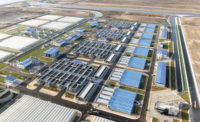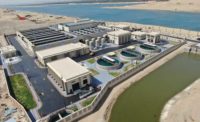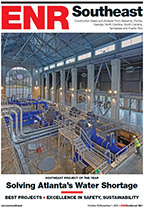West Brook Flood Control Project, Roselle Borough, N.J.
This region of New Jersey is traversed by a number of streams, collectively referred to as West Brook. During heavy rains, they would unleash a torrent of flood waters, overrunning streets, homes and businesses.
This project sought to increase capacity by deepening, widening and stabilizing the banks of a two-mile stretch of crumbling stones, dilapidated walls and overgrown shrubbery.
The revitalization project, which excavated up to 4 ft of the brook's bottom and widened it up to 40 ft, included the relocation and/or replacement of 100-year-old utilities, including electric, water and gas mains.
The team installed geomats to encourage plant growth, assist in bank stabilization and help reduce erosion. They also installed gabion stone to help stabilize bank walls.
The$10.5-million flood-control undertaking weathered through its first major test—Superstorm Sandy—whose winds caused toppled trees and debris that the team had to quickly address without delaying the project.
Biweekly construction progress meetings were held to help in the effort. If a storm was anticipated, precautionary measures were coordinated days in advance, which minimized cleanup and downtime.
The project also called for in-the-field modifications due to new residential and commercial property additions. Many areas were redesigned on-the-fly while maintaining the overall integrity of the design plans.
Coordination efforts with the general contractor, subcontractors and utility companies were critical to make sure that plan specifications were met along the way. Since the brook flows between houses, businesses, beneath roadways and behind schools and residences, collaboration was paramount to help reduce daily inconveniences to all.
The team says that constant communication among multiple agencies and the surrounding community contributed to the project's successful completion.
The project also included a large public outreach campaign that included coordination with emergency services and schools. The campaign began with overall general meetings to address concerns and inform the community on the magnitude of the project as well as what to expect. This was followed up by breakout meetings with those individuals who were affected more than others.
The use of social media and Web-based applications also helped spread the word. Emergency text updates alerted residents to construction activities, detours and utility shutdowns. The team says this helped enable the project, which was initially estimated to last for two years, to be completed in 18 months.
The project sought to upgrade aging infrastructure and enable the Roselle Borough to move forward with redevelopment and community revitalization programs, but it also benefited nearby communities that share waterways and aging infrastructures.
One judge commented that the project, which is designed to handle 100-year storm events, "delivered back to the community an aesthetically pleasing, functional and well-executed" site.
Key Players
Owner/Developer: Borough of Roselle, N.J.
General Contractor: Montana Construction Corp.
Lead Designer: County of Union, N.J.
Civil Engineer/Consultant: Maser Consulting PA; M. Disko Associates








Post a comment to this article
Report Abusive Comment